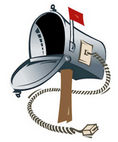1900-1909
1900
- De Forest patents device to improve weak signals.
-
Nikola Tesla 1856-1943
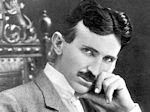 Tesla was born in Croatia, but moved to the United States in 1884. Following his move he worked for Thomas Edison designing dynamos, and then established his own laboratory in 1887.
Tesla was born in Croatia, but moved to the United States in 1884. Following his move he worked for Thomas Edison designing dynamos, and then established his own laboratory in 1887.
Tesla's work laid the foundations for large scale electric power generation and transmission. Tesla experimented with high frequency alternators and invented the 'Tesla Coil' as a means for even higher voltages. His work included the for runner of the neon and fluorescent lights, he predicted radio as a means of communication in 1893, and spent a large amount of time in an effort to transmit electric power without wires. He built the largest Tesla coil ever made at Colorado Springs - a twelve million volt device which drew an arc up to 135 feet in length.Other predictions by Tesla included radar in 1917, and radio services of pictures, time, and weather information in 1900.
-
Reginald Fessenden theorizes that an alternator, as developed by Tesla, could generate an electromagnetic wave able to carry voice and music. He uses a spark generator to send the human voice the distance of about one mile.
1901
- Marconi receives the letter "S" by Morse code (35 K Wav of a spark transmitter) in St. Johns, Newfoundland. John A. Fleming was at the transmitter in England.
- Canadian Marconi Stations constructed.
- Marconi's antenna farm at Poldhu, England is constructed.
- Karl Ferdinand Braun introduces the use of a crystal detector as part of a wireless receiver.
- July: Tesla begins construction of his Wardenclyffe Tower wireless transmission facility. The project runs out of funding by 1905 and is never completed.
- December: Marconi claims to have received in St. John's, Newfoundland a radio signal transmitted from Poldhu in Cornwall (UK).
1902
- Reginald Fessenden invents the “electrolytic detector”
- De Forest Wireless Telegraph Company is formed.
- The magnetic detector is invented by Marconi.
- Fessenden forms the National Electric Signaling Company.
- The DeForest Wireless Telegraph Company is formed.
- DeForest wins gold medal at St. Louis World’s Fair for “spade detector.”
- February-Marconi starts conducting more organized and documented tests sailing on board the SS Philadelphia west from Great Britain recording signals sent daily from the Poldhu station showing reception up to 2,100 miles (3,400 km).
- December-the Marconi station in Glace Bay, Nova Scotia, Canada transmits the first signal from North America back to Great Britain.
1904
- John Ambrose Fleming 1849-1945
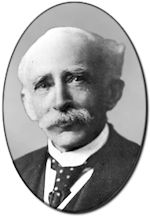 Fleming was born in Lancaster, England and studied electricity and mathematics under James Clerk Maxwell. He served a number of electric lighting companies as advisor and engineer, and was a scientific consultant for the Marconi Company from 1899-1905. Besides his work in theory, he was also active in the practical application of his work. He made improvements in electric lamps, generators, and many pieces of radio-telegraph apparatus.
Fleming was born in Lancaster, England and studied electricity and mathematics under James Clerk Maxwell. He served a number of electric lighting companies as advisor and engineer, and was a scientific consultant for the Marconi Company from 1899-1905. Besides his work in theory, he was also active in the practical application of his work. He made improvements in electric lamps, generators, and many pieces of radio-telegraph apparatus.
In 1904, while searching for a better detector for wireless signals he recalled his work for Edison in the early 1880's - and the phenomenon known as the Edison Effect. He fashioned a lamp with a metal cylinder surrounding the filament, ran wires to the outside of the envelope - and started the industry of electronics with his electrical 'valve'.
The Fleming Valve-John Ambrose Fleming invents the first tube, the "Fleming Valve", or as he called it..an Oscillation Valve. His valve is a two element rectifier, made by inserting a metal plate in one of Edison's electric light bulbs.
Fleming serves as a scientific consultant to the Marconi company, and designs many pieces of early wireless apparatus. He is charged to develop a new detector for wireless signals. - The U.S. Patent Office reversed its decision, awarding Marconi a patent for the invention of radio.
1906
- The 'Alexanderson Alternator' is delivered to Fessenden's station. On Christmas Eve, 1906 he broadcasts speech and music to surprised shipboard operators. He broadcasts on 42 Kilohertz at 1 kilowatt. The programming includes a female voice singing a Christmas carol, a violin solo by Fessenden, and an invitation to report on reception.
Reginald Aubrey Fessenden 1866-1932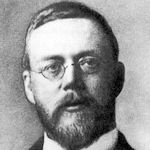 Fessenden, a Canadian born in East Bolton, Quebec worked as a tester and Chemist in the Edison Machine works of New York, and later at Edison's laboratory in New Jersey. Among his patents were the electrolytic detector - far more sensitive than other early methods of detection, and the process of 'heterodyning' a signal - mixing it with another frequency to create a 'sum' and 'difference' of the original frequency.
Fessenden, a Canadian born in East Bolton, Quebec worked as a tester and Chemist in the Edison Machine works of New York, and later at Edison's laboratory in New Jersey. Among his patents were the electrolytic detector - far more sensitive than other early methods of detection, and the process of 'heterodyning' a signal - mixing it with another frequency to create a 'sum' and 'difference' of the original frequency.
Personally, he is said to have been a bit arrogant - using phrases such as 'Don't try to think - you haven't the brain for it'. He obtained over 500 patents in his lifetime, many for advances in the art of radio. - Henry H.C. Dunwoody patents the use of carborundum in detectors.
- Lee DeForest 1873-1961
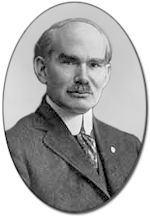 Born in Council Bluffs, Iowa to a Congregational minister, Lee Deforest made his greatest contribution to radio and electronics with his invention of the Triode. Although he flooded the patent office with ideas, only a relative few of his over 300 patents proved important.
Born in Council Bluffs, Iowa to a Congregational minister, Lee Deforest made his greatest contribution to radio and electronics with his invention of the Triode. Although he flooded the patent office with ideas, only a relative few of his over 300 patents proved important.
In the early years of radio he installed many wireless transmitting stations, and his became one of the most famous of the early companies. His business sense however, was lacking, and he was taken advantage of by several associates.
He concentrated his efforts on moving pictures in the 1920's - claiming the field of radio was getting too crowded. Later years found him suing other inventors - notably Howard Armstrong - for patent infringement.
Lee DeForest patents the "Audion" as a "new receiver for wireless telegraphy." He added a 'Grid' to the Fleming Valve, creating the 'Triode'. - In Australia, Ernest Fisk (later Sir Ernest) of AWA – Amalgamated Wireless (Australasia) conducted an isolated experiment in which music was broadcast.
1907
- The first 'Broadcasts' of records are done to aid in testing, so the operator didn't have to talk.
- The worlds first Trans-Atlantic commercial wireless service is established by Marconi with stations at Clifden, Ireland and Glace Bay, Nova Scotia.
1909
- Braun and Marconi share the Nobel Prize in physics for their work in the development of wireless telegraphy.
- Charles 'Doc' Herrold begins a regular schedule of broadcasts from his "Herrold College of Wireless and Engineering" at San Jose, CA.
- S.S. Republic sinks after a collision. All but two lives are saved with the help of wireless.
Sources: Empire Of The Air
A Timeline Of Radio's Development
WIkipedia: Timeline of Radio
CBN History: Radio/Broadcasting Timeline
Radio and Television Timeline


